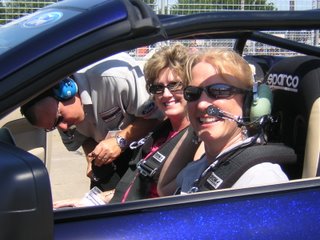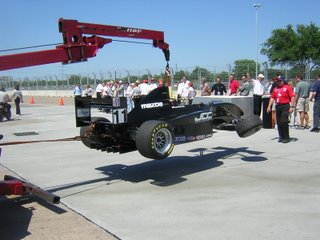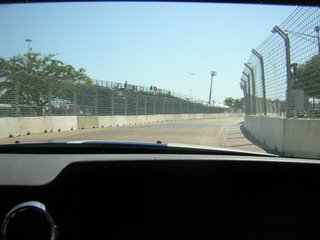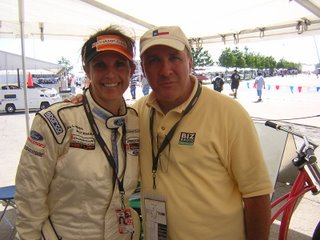 “How fast did you go?” my Bride asked me, breathlessly.
“How fast did you go?” my Bride asked me, breathlessly.“I don’t know—I never got a chance to ask,” I shouted over the din of a passing Ford Mustang as it roared onto the track of The Houston Grand Prix.
The Champ Car Fast Lap team of professional drivers were giving VIP rides around the racecourse in a pack of bona fide, souped-up Mustangs for a taste of what it’s like to be propelled towards an oncoming wall at speeds measured in three-digits.
 Welcome to the side show at the 2006 Houston Grand Prix.
Welcome to the side show at the 2006 Houston Grand Prix.Our drivers were part of the squad of official pace car drivers who escort the race cars onto the track and through their first warm-up laps before the race is officially begun with the wave of a green flag.
 When the yellow flag is waved, signifying a problem somewhere on the course, the Pace Car Team springs into action, and onto the course to shepherd the race cars through the trouble spots.
When the yellow flag is waved, signifying a problem somewhere on the course, the Pace Car Team springs into action, and onto the course to shepherd the race cars through the trouble spots.As if.
These ladies are like “Charlie’s Angels” and “The Magnificient 7” all rolled into one.
Fearless but sensible.
Feminine but definitely not racy.
Nervy…absolutely.
 Allison Altzman waltzed me around the track in an honest-to-goodness stock racer: A 2006 Mustange GT/CS with a 5.0-litre, 500-hp engine harnessed to a T-56 6-speed racing transmission. This was the real deal, not just a souped-up street car.
Allison Altzman waltzed me around the track in an honest-to-goodness stock racer: A 2006 Mustange GT/CS with a 5.0-litre, 500-hp engine harnessed to a T-56 6-speed racing transmission. This was the real deal, not just a souped-up street car.Allison was born into a racing family and is now the SVP of Danny McKeever’s Fast Lane Racing School in Valencia, California. Danny’s her dad. Allison and her husband have two small children, who now implore their mom to time their laps as they run a go-cart around the family compound. Looks like this could be a three-generational trend.
 Racing schools are popping up all over the country, as wanna-be race drivers give themselves the chance to live out their dreams of taking a fast car out on a skid pad or a test track to “see what she can do.”
Racing schools are popping up all over the country, as wanna-be race drivers give themselves the chance to live out their dreams of taking a fast car out on a skid pad or a test track to “see what she can do.”But there is a more sober side to this speed business.
Education: It’s widely known that the driver education instruction our youth now receive in order to become licensed drivers is more all about passing the test and having the minimum required knowledge of traffic rules. Maybe that’s why more kids are killed in traffic accidents in their teens than in their twenties, after they’ve had a few years of practical experience.
It’s obvious that the State of Texas tacitly recognizes that the state-mandated driver’s ed courses are not adequately equipping youthful drivers for all conditions, because of the staggered levels of licensing now in effect.
 What if you could put your youthful driver—or yourself—in your car on a skid pad? Not to see “what she can do,” but rather to determine how that vehicle will respond in an emergency situation. How much braking is required to lock up the steering? What would really happen in a skid—and how would it feel to steer out of it?
What if you could put your youthful driver—or yourself—in your car on a skid pad? Not to see “what she can do,” but rather to determine how that vehicle will respond in an emergency situation. How much braking is required to lock up the steering? What would really happen in a skid—and how would it feel to steer out of it?That kind of practical, educational experience is not being given in today’s driving schools, which is why many teens’ impression of driving is as just another ride at Disney.
There’s no respect for the laws of physics, inertia, and friction—because the extremes of those envelopes in their personal vehicle have never been explored under supervision and instruction.
Allison expressed to me a level of frustration because the school systems are turning a blind eye to the problem, and the insurance companies lobbying the states—who should have a vested interest in keeping accident losses at a minimum—don’t acknowledge the connection. Yet.
 There are subtle changes happening for the better. In the meantime, Allison and her Sisters in Speed, tour the country giving thrill rides to race fans…and curious journalists and their wives.
There are subtle changes happening for the better. In the meantime, Allison and her Sisters in Speed, tour the country giving thrill rides to race fans…and curious journalists and their wives.Driving home the point (pun intended) that this is serious business…on the track and off.
No comments:
Post a Comment